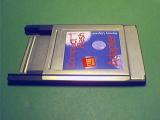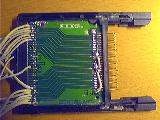 |
The Flash memory adapter |


CompactFlash cards are really smart. They can be used exactly as
an ATA disk if wired to work in "True IDE mode". For this, take
a long IDE flat ribbon (about 40 cm) and your CF-PCMCIA adapter.
Explode the last one to gain access to the solder pins, and wire
the ribbon to it as follows. Please note that poorly soldered
wires may cause filesystem corruption. Once properly wired,
insert your CF card in the adapter, plug the ribbon to the IDE
connector and try the "hard disk autodetection" in the machine's
setup program. The CF card will be seen as a hard disk and will be
used as such.


CompactFlash to ATA Connection table
| CF pin | IDE pin | | CF pin |
IDE pin | | CF pin | IDE pin |
| CF pin | IDE pin |
1,8,9,10,
11,12,14,
15,16,17,50 | GND | | 29 | 14 | | 19 | 33 | | 40 | NC |
| 2 | 11 | | 30 | 16 | | 20 | 35 | | 41 | 1 |
| 3 | 9 | | 31 | 18 | | 21 | 17 | | 42 | 27 |
| 4 | 7 | | 32 | 38 | | 22 | 15 | | 43 | NC |
| 5 | 5 | | 33 | NC | | 23 | 13 | | 45 | 39 |
| 6 | 3 | | 34 | 25 | | 24 | 32 | | 46 | 34 |
| 7 | 37 | | 35 | 23 | | 25,26 | NC | | 47 | 4 |
| 13,36,38,44 | Vcc | | 37 | 31 | | 27 | 10 | | 48 | 6 |
| 18 | 36 | | 39 | M/S | | 28 | 12 | | 49 | 8 |
Notes :
- NC (Not Connected) means that pins 25,26,33,40,43 on the CF remain open.
- GND (ground) is to be connected to both ATA pins 2 and 40.
- Vcc is the +5 volts, taken from the red wire on a floppy power plug.
- M/S (master/slave) : GND for master, Vcc for slave.
If you intend to try hotplug facility, you have to push pin 9 of the
CF a bit like power pins, to allow it to be connected before the power
comes up to the CF, because it's used to determine wether the card
will work in TrueIDE mode. (it's easy with a solder iron, simply warm
the pin several seconds and push strong). It appears that the CF
outputs are not open drain, thus causing problems when connected to an
ATA bus hosting other devices. If you need to use other devices, you
should connect the CF to a separate IDE controller (you know, those
$10 ISA or PCI cards).
|
|
 |



